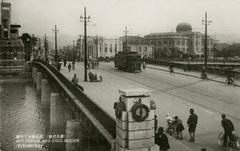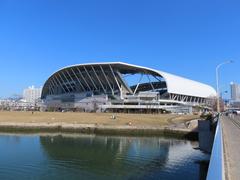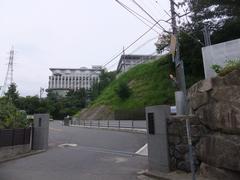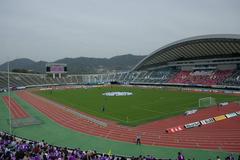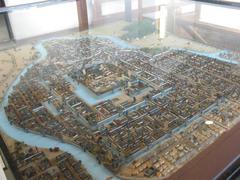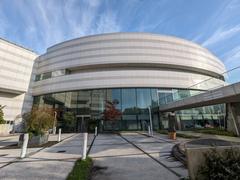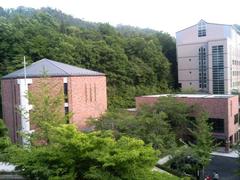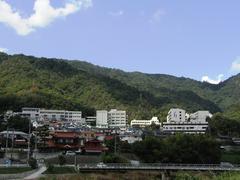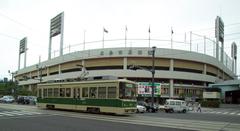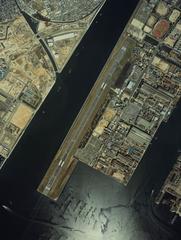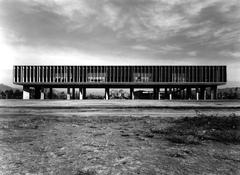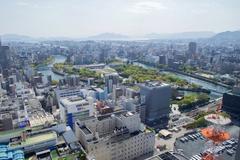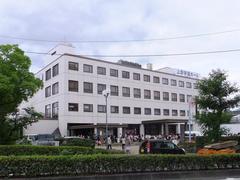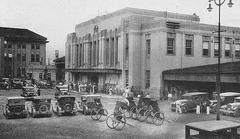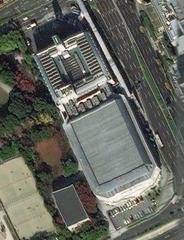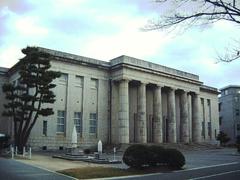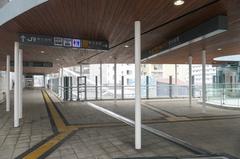
Shin-Inokuchi Station Visiting Hours, Tickets, and Hiroshima Historical Sites Guide
Date: 04/07/2025
Introduction: Shin-Inokuchi Station and Its Significance in Hiroshima
Located in the vibrant Nishi-ku district of Hiroshima, Shin-Inokuchi Station is a vital transportation hub linking the city’s western suburbs to regional and national networks. As a key stop on the JR West Sanyō Main Line and an intersection for local transit systems like the Hiroshima Electric Railway (Hiroden), it provides efficient access for commuters, tourists, and anyone seeking to explore Hiroshima’s unique blend of history and modernity. The station’s strategic role, combined with Hiroshima’s postwar resilience and urban growth, makes it not only a pivotal gateway but also a window into the city’s enduring spirit.
Hiroshima, renowned for its tragic history and ongoing commitment to peace, is home to world-famous sites such as the Hiroshima Peace Memorial (Atomic Bomb Dome)—a UNESCO World Heritage Site easily reached from Shin-Inokuchi via local transit. This guide offers a comprehensive overview of the station’s history, facilities, ticketing, accessibility, and surrounding attractions. It also provides practical travel tips for navigating the area, ensuring a seamless and enriching visit.
For up-to-date information and detailed travel planning, consult resources such as the Hiroshima City Official Website, JR West Timetables, and the Hiroshima Peace Memorial Museum.
Contents
- Welcome to Shin-Inokuchi Station: Your Gateway to Hiroshima’s Western Suburbs
- Early Development and Strategic Location
- Postwar Reconstruction and Urban Expansion
- Integration into the Regional Rail Network
- Urban Redevelopment and Modernization
- Socioeconomic Significance
- Architectural Features and Accessibility
- Visiting Hours and Ticketing Information
- Nearby Attractions and Travel Tips
- Photographic Spots and Special Features
- Frequently Asked Questions (FAQ)
- Station Layout, Facilities, and Accessibility
- Platform Configuration and Track Arrangement
- Station Building and Concourse
- Historical and Cultural Significance
- Special Events and Guided Tours
- Facilities
- Ticketing and Information Services
- Waiting Areas, Restrooms, and Amenities
- Retail, Dining, and Luggage Services
- Connectivity and Transfers
- Accessibility
- Barrier-Free Design
- Assistance Services
- Signage and Multilingual Support
- Parking and Bicycle Facilities
- Additional Visitor Tips
- Safety and Cleanliness
- Hiroshima Peace Memorial (Atomic Bomb Dome) Overview
- History and Cultural Significance
- Visiting Hours and Tickets
- How to Get There
- Nearby Attractions
- Accessibility
- Special Events and Tours
- Photographic Spots
- Practical Tips for Visitors
- FAQs
- Visuals and Media
- Related Articles
- Conclusion
- Sources
Welcome to Shin-Inokuchi Station: Your Gateway to Hiroshima’s Western Suburbs
Shin-Inokuchi Station serves as an essential node in Hiroshima’s transit landscape, granting easy access to residential areas, shopping districts, sports venues, and historical sites. For commuters and visitors alike, the station provides a smooth, well-equipped starting point for journeys through Hiroshima and beyond. This guide details everything you need to know to make the most of your visit, from historical context to ticketing and accessibility.
Early Development and Strategic Location
Hiroshima’s growth as a transportation and economic hub began with its advantageous position on the Seto Inland Sea. The arrival of the Sanyō Railroad in 1894 was a turning point, connecting the city to Kobe and Shimonoseki and laying the groundwork for suburban stations like Shin-Inokuchi (aboutjapan.japansociety.org). These developments fostered the city’s modernization and later expansion.
Postwar Reconstruction and Urban Expansion
After the devastation of 1945, Hiroshima’s reconstruction focused on building modern infrastructure to foster economic revival. Key projects included the completion of Hiroshima Station and electrification of regional rail lines. Shin-Inokuchi Station emerged during this period, connecting expanding residential and commercial zones to the city center (city.hiroshima.lg.jp).
Integration into the Regional Rail Network
The 1975 introduction of the Sanyō Shinkansen further integrated Hiroshima into the national high-speed rail system, with Shin-Inokuchi facilitating connections for local and regional travelers. The station’s links to Hiroden trams and regional buses support seamless multimodal transit (city.hiroshima.lg.jp).
Urban Redevelopment and Modernization
Redevelopment initiatives around Shin-Inokuchi Station, including new commercial facilities and improved public amenities, have transformed Nishi-ku into an attractive suburban hub. Modern infrastructure improvements, such as expressway access and expanded tram routes, further enhance the area’s connectivity (city.hiroshima.lg.jp).
Socioeconomic Significance
The station plays a crucial role in supporting Hiroshima’s western districts, providing residents with reliable access to employment, education, and commerce, and encouraging balanced urban growth.
Architectural Features and Accessibility
Shin-Inokuchi Station is designed for efficient, barrier-free travel. Its two island platforms serve four tracks, with elevators, escalators, and tactile paving facilitating easy movement for all passengers. Recent upgrades have enhanced waiting areas, ticketing facilities, and multilingual signage (westjr.co.jp).
Visiting Hours and Ticketing Information
- Station Operating Hours: Approximately 5:00 AM to midnight daily; ticket offices typically operate from 6:00 AM to 10:00 PM. Always check the latest schedules (JR West Timetables).
- Tickets: Purchase at automated machines or counters. IC cards (ICOCA, Suica) offer convenient tap-in/out, and the JR Kansai-Hiroshima Area Pass provides cost-effective regional travel.
- Lockers and Amenities: Coin lockers, accessible restrooms, and information counters are available for visitors’ convenience.
Nearby Attractions and Travel Tips
- Mazda Stadium: Home to Hiroshima Toyo Carp, a short ride from the station.
- Inokuchi Shopping District: Offers malls, restaurants, and local shops.
- Seto Inland Sea: Accessible for scenic day trips.
- Travel Tips: Use digital transit apps for schedules, travel during off-peak hours for comfort, and allow extra time if visiting during events.
Photographic Spots and Special Features
Shin-Inokuchi’s modern station design, set against suburban landscapes and green spaces, creates appealing photo opportunities, especially during sunrise and sunset.
Frequently Asked Questions (FAQ)
Q: What are Shin-Inokuchi Station’s opening hours?
A: 5:00 AM to midnight daily; ticket offices from 6:00 AM to 10:00 PM.
Q: How can I buy tickets?
A: At ticket machines, counters, or with IC cards and passes.
Q: Are there lockers?
A: Yes, coin lockers are available.
Q: Is the station accessible?
A: Yes, it features elevators, escalators, barrier-free design, and accessible restrooms.
Q: What attractions are nearby?
A: Mazda Stadium, shopping districts, and scenic Seto Inland Sea spots.
Station Layout, Facilities, and Accessibility
Platform Configuration and Track Arrangement
Two island platforms serve four tracks, facilitating smooth transfers. Platforms are accessible via stairs, escalators, and elevators, with bilingual signage for easy navigation.
Station Building and Concourse
The north-side main building offers ticketing, waiting areas, and amenities. Wide passageways and large windows create an open, welcoming space. Automated gates accept IC cards and paper tickets, with multilingual support at machines and counters.
Facilities
Ticketing and Information Services
Multiple vending machines (with English support), a Midori no Madoguchi office for complex or reserved tickets, and real-time digital schedule boards are available.
Waiting Areas, Restrooms, and Amenities
Comfortable seating, vending machines, and accessible restrooms (including family facilities) provide comfort for all travelers.
Retail, Dining, and Luggage Services
Convenience stores and eateries are located in the station. Nearby shopping centers offer additional options. Coin lockers accommodate various luggage sizes.
Connectivity and Transfers
A short walk connects to the Hiroden Inokuchi tram stop and local/regional bus services, providing easy access to central Hiroshima and beyond.
Accessibility
Barrier-Free Design
Elevators, escalators, tactile paving, and accessible restrooms ensure accessibility for all.
Assistance Services
Staff are available for assistance with boarding, navigation, and luggage. Advance notice is recommended for special needs.
Signage and Multilingual Support
Signage and digital displays are provided in Japanese, English, Chinese, and Korean.
Parking and Bicycle Facilities
Ample parking (including for persons with disabilities) and bicycle racks encourage eco-friendly travel.
Additional Visitor Tips
- Peak Hours: Avoid weekday rush periods for a more relaxed experience.
- Nearby Attractions: Consider Hiroshima SunPlaza and local fitness centers.
- Luggage: Use delivery services for convenience.
- Wi-Fi: Portable Wi-Fi or SIM cards are recommended, as free public Wi-Fi is limited.
Safety and Cleanliness
The station maintains high standards of cleanliness and safety with regular cleaning, security cameras, and clear emergency procedures (AEDs onsite).
Hiroshima Peace Memorial (Atomic Bomb Dome): Visiting Hours, Tickets, and Guide
History and Cultural Significance
The Hiroshima Peace Memorial (Atomic Bomb Dome), a UNESCO World Heritage Site, preserves the ruins of the 1915 Hiroshima Prefectural Industrial Promotion Hall. It stands as a powerful symbol of the devastation of August 6, 1945, and the global quest for peace (UNESCO World Heritage Listing).
Visiting Hours and Tickets
- Peace Memorial Park: Open 24/7, free to enter.
- Peace Memorial Museum: 8:30 AM–6:00 PM (longer hours in summer, shorter in winter), last entry 30 minutes before closing. ¥200 for adults, discounts for students, free for children.
- Guided Tours: Available in several languages, providing historical context and personal stories (hpmmuseum.jp).
How to Get There
- From Shin-Inokuchi: Take Hiroden tram Line 1 or 2 to Genbaku Dome-mae Station (about 15 minutes).
- From Hiroshima Station: Tram to Genbaku Dome-mae or bus routes to Peace Memorial Park.
Nearby Attractions
- Peace Memorial Museum: In-depth exhibits on the bombing.
- Children’s Peace Monument: Commemorates child victims.
- Shukkeien Garden: Traditional Japanese garden.
- Hondori Shopping Street: Dining and souvenirs.
Accessibility
The park and museum are wheelchair accessible, with ramps, elevators, and accessible restrooms. Service animals are allowed.
Special Events and Tours
- Peace Memorial Ceremony: Held every August 6.
- Night Illuminations: Special occasions.
- Virtual Tours: Available via the museum website.
Photographic Spots
Capture the dome against the Motoyasu River, especially at sunrise or sunset. The Peace Flame and Cenotaph are also poignant locations.
Practical Tips for Visitors
- Best Times: Early morning or late afternoon for fewer crowds and softer light.
- Weather: Prepare for rain in June–July; dress accordingly.
- Tickets: Purchase museum tickets in advance during busy periods.
- Language: Multilingual signage and audio guides are available.
Frequently Asked Questions (FAQ)
Q: Is the Atomic Bomb Dome free to visit?
A: Yes, the dome and park are free; a ticket is required for the museum.
Q: Are English tours available?
A: Yes, check the official museum website for details.
Q: Can I visit at night?
A: The park is open 24 hours, but daytime visits are recommended for safety and visibility.
Q: How much time should I allow?
A: 2–3 hours for the park, museum, and key monuments.
Visuals and Media
Include images of Shin-Inokuchi Station’s platforms, accessibility features, and the Atomic Bomb Dome, with descriptive alt tags such as “Shin-Inokuchi Station platform with accessibility features” and “Hiroshima Peace Memorial Atomic Bomb Dome at sunset.”
Embed interactive maps or virtual tours from the official museum website if available.
Related Articles
- How to Use ICOCA and Suica Cards in Hiroshima
- Top Historical Sites to Visit in Hiroshima
Conclusion
Shin-Inokuchi Station is not only a vital transit hub but also the perfect starting point for exploring Hiroshima’s rich historical and cultural landscape. With its modern, accessible facilities and connections to key sites like the Hiroshima Peace Memorial, your journey through western Hiroshima is sure to be convenient and deeply rewarding.
For more travel tips, event updates, and cultural insights, download the Audiala app and follow us on social media. Start planning your visit today and unlock the full experience of Hiroshima’s western suburbs and historical treasures.
Sources
- Shin-Inokuchi Station: Visiting Hours, Tickets, and Exploring Hiroshima’s Western Suburbs, 2025, (aboutjapan.japansociety.org)
- Hiroshima City Official Website Overview, 2025, (city.hiroshima.lg.jp)
- JR West Hiroshima Station Timetable and Facilities, 2025, (westjr.co.jp)
- Essential Japan: JR Kansai-Hiroshima Area Pass Guide, 2025, (essential-japan.com)
- Hiroshima Peace Memorial Museum Official Website, 2025, (hpmmuseum.jp)
- UNESCO World Heritage Listing for Hiroshima Peace Memorial, 2025, (whc.unesco.org)
- JR West Official Station Information, 2025, (jr-odekake.net)
- Japan Travel Guide: Hiroshima Complete Guide, 2025, (japan.travel)

